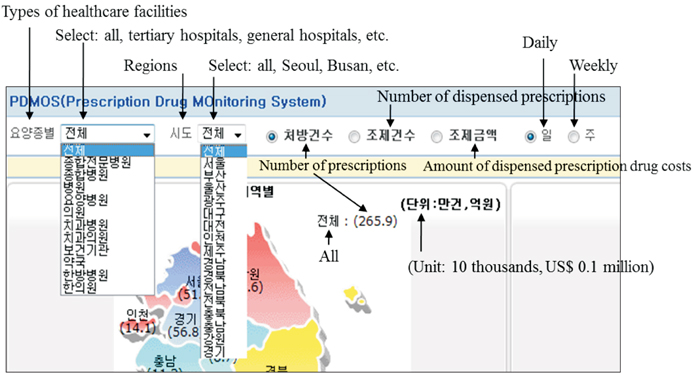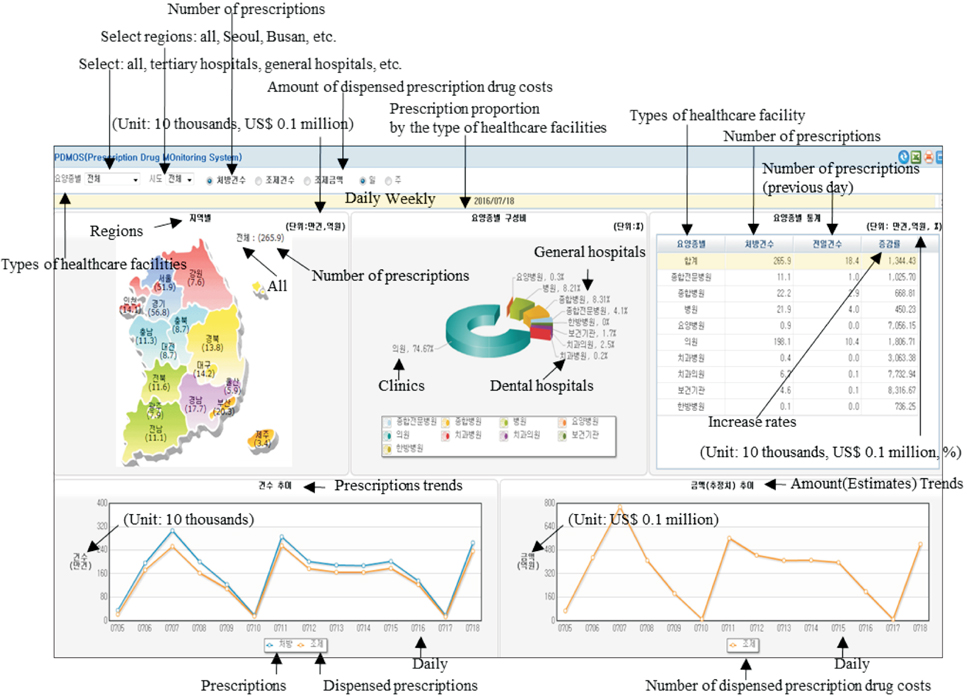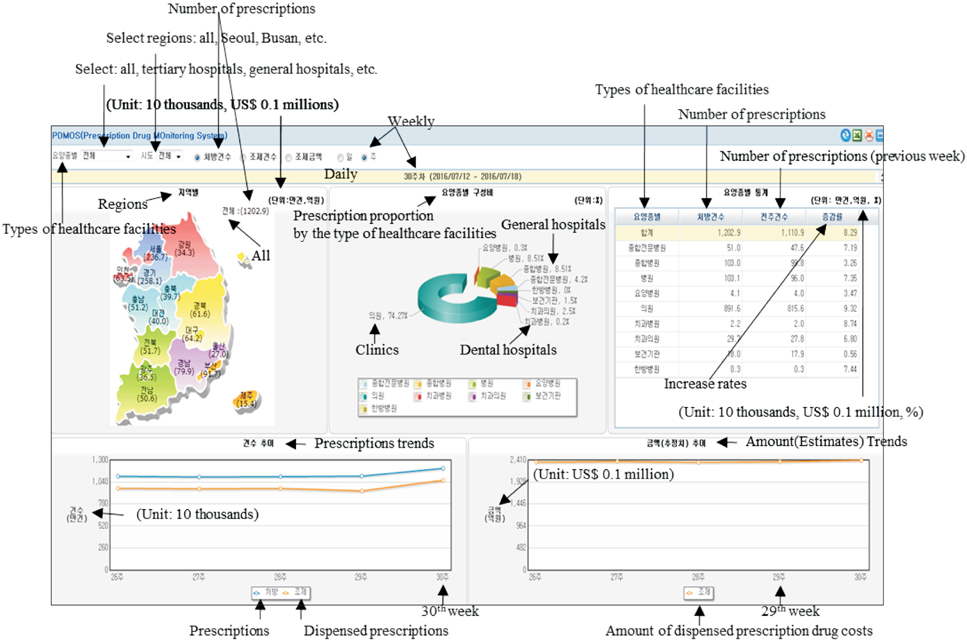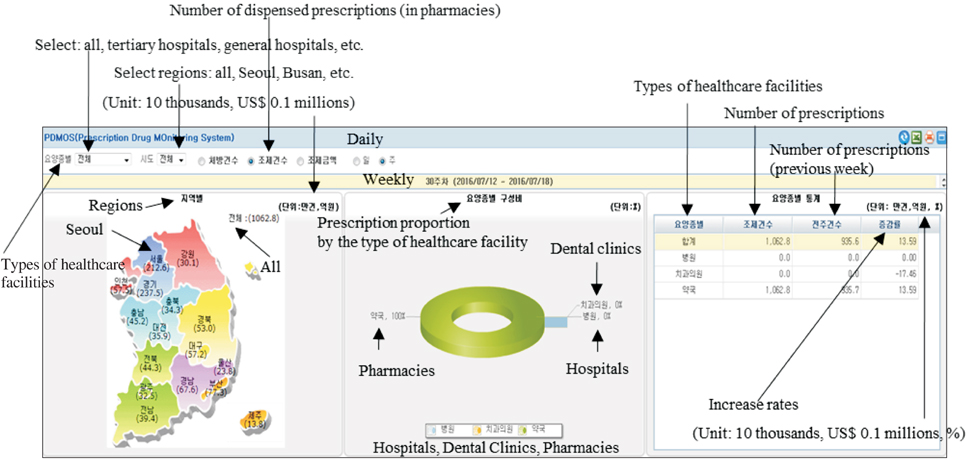Healthc Inform Res.
2016 Jul;22(3):178-185. 10.4258/hir.2016.22.3.178.
Constructing a Real-Time Prescription Drug Monitoring System
- Affiliations
-
- 1Research Institute for Health Insurance Review & Assessment, Health Insurance Review & Assessment Service, Wonju, Korea. pyt0601@hira.or.kr
- 2Ministry of Health, Wellington, New Zealand.
- KMID: 2357396
- DOI: http://doi.org/10.4258/hir.2016.22.3.178
Abstract
OBJECTIVES
The objective of this investigation was to demonstrate the possibility of the construction of a real-time prescription drug monitoring system (PDMOS) using data from the nationwide Drug Utilization Review (DUR) system in Korea.
METHODS
The DUR system collects information on drug prescriptions issued by healthcare practitioners and on drugs dispensed by pharmacies. PDMOS was constructed using this data. The screen of PDMOS is designed to exhibit the number of drug prescriptions, the number of prescriptions dispensed by pharmacies, and the dispensed prescription drug costs on a daily and weekly basis. Data was sourced from the DUR system between June 1, 2016 and July 18, 2016. The TOGA solution developed by the EYEQMC Co. Ltd. of Seoul, Korea was used to produce the screen shots.
RESULTS
Prescription numbers by medical facilities were more numerous than the number of prescriptions dispensed by pharmacies, as expected. The number of prescriptions per day was between 2 to 3 million. The prescriptions issued by primary care clinics were most numerous, at 75% of the total number of prescriptions. Daily prescription drug costs were found to be approximately US $50 million. The prescription drug costs were highest on Mondays and were reduced towards the end of the week. Prescriptions and dispensed prescriptions numbered approximately 1,200 and 1,000 million, respectively.
CONCLUSIONS
The construction of a real-time PDMOS has been successful to provide daily and weekly information. There was a lag time of only one day at the national level in terms of information extraction, and scarcely any time was required to load the data. Therefore, this study highlights the potential of constructing a PDMOS to monitor the estimate the number of prescriptions and the resulting expenditures from prescriptions.
MeSH Terms
Figure
Cited by 2 articles
-
Real-Time Monitoring System to Manage Mental Healthcare Emergency Unit
Samy Housbane, Adil Khoubila, Khaoula Ajbal, Mohamed Agoub, Omar Battas, Mohamed Bennani Othmani
Healthc Inform Res. 2020;26(4):344-350. doi: 10.4258/hir.2020.26.4.344.HEDEA: A Python Tool for Extracting and Analysing Semi-structured Information from Medical Records
Anshul Aggarwal, Sunita Garhwal, Ajay Kumar
Healthc Inform Res. 2018;24(2):148-153. doi: 10.4258/hir.2018.24.2.148.
Reference
-
1. National Center for Health Statistics. Health, United States, 2015: with special feature on racial and ethnic health disparities. Hyattsville (MD): National Center for Health Statistics;2016.2. Health Insurance Review and Assessment Service. 2015 National healthcare expenditure statistics. Wonju: Health Insurance Review and Assessment Service;2016.3. Shin HC, Park YT, Lee YT, Jo EC. Healthcare utilization monitoring system in Korea. Healthc Inform Res. 2015; 21(3):184–190.
Article4. Peterson AM, Chan V, Wilson MD. Drug utilization review strategies. In : Navarro RP, editor. Managed care pharmacy practice. 2nd ed. Sudbury (MA): Jones and Bartlett Publishers;2008. p. 215–232.5. United States General Accounting Office. Prescription drugs: state monitoring programs provide useful tool to reduce diversion (GAO-02-634). Washington (DC): United States General Accounting Office;2002.6. Reifler LM, Droz D, Bailey JE, Schnoll SH, Fant R, Dart RC, et al. Do prescription monitoring programs impact state trends in opioid abuse/misuse? Pain Med. 2012; 13(3):434–442.
Article7. Clark T, Eadie J, Kreiner P, Strickler G. Prescription drug monitoring programs: an assessment of the evidence for best practices. Waltham (MA): Brandeis University;2012.8. Finklea K, Sacco LN, Bagalman E. Prescription drug monitoring programs. J Drug Addict Educ Erad. 2014; 10(4):481–505.9. National Alliance for Model State Drug Laws. 2015 Annual review of prescription monitoring programs. Charlottesville (VA): National Alliance for Model State Drug Laws;2015.10. Hildebran C, Cohen DJ, Irvine JM, Foley C, O'Kane N, Beran T, et al. How clinicians use prescription drug monitoring programs: a qualitative inquiry. Pain Med. 2014; 15(7):1179–1186.
Article11. Hackman DT, Greene MS, Fernandes TJ, Brown AM, Wright ER, Chambers RA. Prescription drug monitoring program inquiry in psychiatric assessment: detection of high rates of opioid prescribing to a dual diagnosis population. J Clin Psychiatry. 2014; 75(7):750–756.12. Smith RJ, Kilaru AS, Perrone J, Paciotti B, Barg FK, Gadsden SM, et al. How, why, and for whom do emergency medicine providers use prescription drug monitoring programs? Pain Med. 2015; 16(6):1122–1131.
Article13. Ortiz E, Clancy CM. Use of information technology to improve the quality of health care in the United States. Health Serv Res. 2003; 38(2):xi–xxii.
Article14. Girosi F, Meili R, Scoville R. Extrapolating evidence of health information technology savings and costs. Santa Monica (CA): RAND Corporation;2005.15. Fichman RG, Kohli R, Krishnan R. The role of information systems in healthcare: current research and future trends. Inf Syst Res. 2011; 22(3):419–428.
- Full Text Links
- Actions
-
Cited
- CITED
-
- Close
- Share
- Similar articles
-
- A Study on the Web-Based Fuzzy Information System of a Patient Monitor
- Drug Utilization Review (DUR) Policy of Government and Directivity
- Drug Use in the Elderly
- Design of Real-time Ambulance Location Monitoring System using Open API and GPS Based on Web 2.0
- Development of Voice Prescription Service System using Fingerprint Authentication








